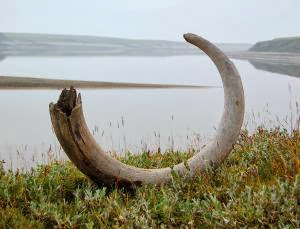
IT WAS the superfoods wot dunnit. Woolly mammoths may have starved to death when changes in the climate deprived them of their best food: flowering herbs.
Perhaps unexpectedly given their size and the chilly climates they lived in, woolly mammoths are thought to have survived on a diet of steppe grasses. But that’s not the whole story. A study of frozen stomach contents and frozen DNA found in the dirt across the Arctic suggests that the ice-age megafauna primarily ate a richer class of plants called forbs.
At first glance the difference seems negligible. Forbs are flowering herbs, and modern examples include clover. But whereas grasses are tough to digest and relatively low in nutrients, forbs are high in protein.
By painstakingly looking at the plant DNA found in permafrost samples dug out of 200 locations across the Arctic, Eske Willerslev at the University of Copenhagen in Denmark and his colleagues were able to paint a picture of the landscape between 50,000 years ago and today. They found that at first, the far north was covered in a rich diversity of forbs. What’s more, the gut contents of some of the big animals that lived in the region, like mammoths and woolly rhinoceroses, showed that these nutritious wild flowers were an important part of their diet (Nature, DOI: 10.1038/nature12921).
“This is technically a great achievement,” says Adrian Lister of the Natural History Museum in London.
But the forbs didn’t last. “Around 20,000 years ago, at the height of the ice age, the environment became very, very cold and dry, and we see a major drop-off in the diversity of forbs,” says Willerslev. “They still dominate the ecosystem, but their diversity declines.”
The real killer came at the end of the ice age 12,000 years ago. Grasses and shrubs began to take the place of the forbs – a change in the landscape that coincided with the decline of the iconic ice-age megafauna. As forbs are stimulated by being trampled underfoot, the decline in forbs from 20,000 years ago probably brought about a feedback cycle in which having fewer animals caused plant diversity to fall, further reducing food supplies and animal populations.
“Our study really changes the general concept that before the last warming period you had a massive grass steppe that was fundamental to sustaining a huge diversity of mammals,” says Willerslev. “In fact it was a diverse steppe of forbs and these were probably crucial.”
The theory may also explain why reindeer were the only big ice-age animalsMovie Camera to survive. Today, reindeer munch on grasses and sedges in summer, and eke a living out of low-energy lichen in the winter. The forbs’ decline would have passed them by.
Note : The above story is based on materials provided by Catherine Brahic to newscientist










